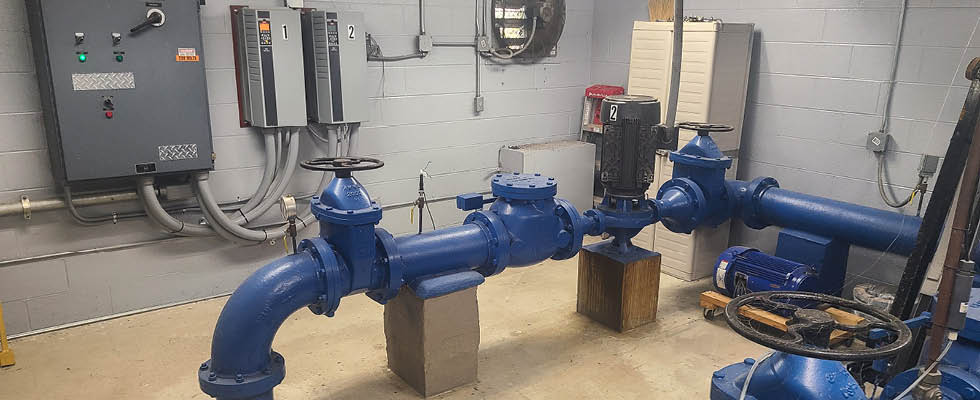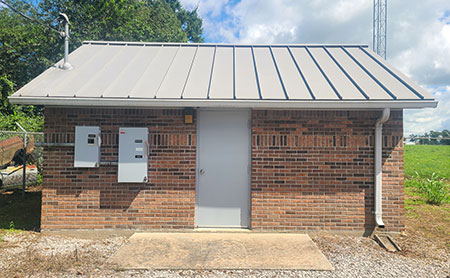
In early 2023, the Warren County Utility District (WCUD) in middle Tennessee was faced with a dilemma. The water tank in their Short Mountain (SM) pressure zone required cleaning and repairs as part of federal compliance regulations, but with only one tank in the pressure zone—as is the case with many rural municipalities—they had few options to maintain water service to users while the tank was out of service during the washout process and while repairs were completed. WCUD maintains a 4.0 millions of gallons per day (mgd) water treatment plant, six storage tanks, four remote pump stations into four pressure zones with approximately 650 miles of mains to serve 9,000 users in rural portions of Warren and five
adjacent counties.
To avoid a catastrophic suspension of service to roughly 400 users in the SM zone, WCUD turned to variable frequency drives (VFDs). The drive they chose includes proportional integral and derivative control (PID), which allows it to maintain discharge pressure in a closed-loop system. By installing the VFD and discharge pressure transducers on the booster pumps, WCUD was able to maintain water service with proper pressure into the SM zone with the tank out of service for three weeks. Instead of feeding water from the tank, the drive was able to effectively convert the booster pump normally used to fill the SM tank into a source—supplying all water to the SM zone and pumping it through the system without needing to send the water through a tank.
Built-In Intelligence
The VFD installed at WCUD provides built-in intelligence for water and wastewater applications. Its variable speed technology enables it to match the daily load variation in treatment plants and pumping stations. By providing motor control on pumps and blowers, the drive can lower energy consumption and, ultimately, operating costs. The VFD feature also decreases wear and tear on equipment, resulting in lower maintenance costs and increased life span.
Dedicated pump-specific features such as cascade control, deragging, drive pump detection, end of curve detection, motor alternation, two-stage ramps (for submersible or vertical turbine pumps), pipe fill mode and smart logic controllers provide process control that can be tailored to meet the various demands of water and wastewater plants. Using the VFD’s soft start capabilities in lift station applications helps reduce wear on the pump as it turns on and off to empty the tank, thereby reducing maintenance costs.

Through condition-based monitoring (CBM), the drive can act as a smart sensor to monitor the condition of the motor and application, detecting issues early so station personnel can find solutions before performance issues have an impact on the plant’s functioning. This is done through edge computing and features such as motor stator winding condition monitoring, mechanical vibration monitoring and load envelope monitoring. Early detection is especially important for municipalities with limited resources. The lack of a cloud subscription requirement reduces cyber-security risks for the plant.
Maintaining the Infrastructure
The WCUD general manager noted the installation and programming process required less than one day, and the soft start capability made the operational transition smooth.
For the duration of the cleaning and repairs project, the drive allowed the pump to maintain water supply into the zone at the programmed discharge pressure even with the SM tank out of service. The drive is linked to a discharge pressure transducer to provide a feedback loop to the VFD.
With its variable speed technology, the drive modulates the motor speed to control the pump flow and maintain the set discharge pressure. When flow increases and pressure drops, the drive speeds up. When the flow decreases and pressure drops, the drive slows down.
Instead of pumping the water to fill a tank and shutting down until the tank drained to a low level, the booster pumps ran continuously for the three-week period, effectively becoming the entire source of water and pressure control for the SM zone, thanks to the VFD. As a result, the 400 users served by the station continued to receive water with no disruptions.
The drive continues to provide benefits post-repairs. With its soft startup, the drive can reduce the power spike from the motors on startup and provides a better power factor in daily operations, helping reduce energy consumption. The drive also performs an invaluable role as the system backup. If a problem with the tank should occur, the drive can keep the pump operating and water flowing to users.
Rural municipalities have limited financial resources and equipment, and taking tanks out of service for required maintenance can present a challenge, but using a VFD can provide a cost-effective and energy-efficient solution to maintain operations and infrastructure.

